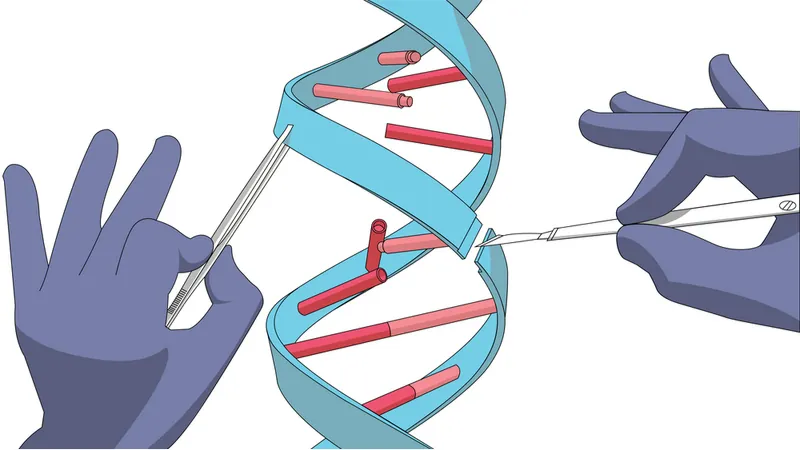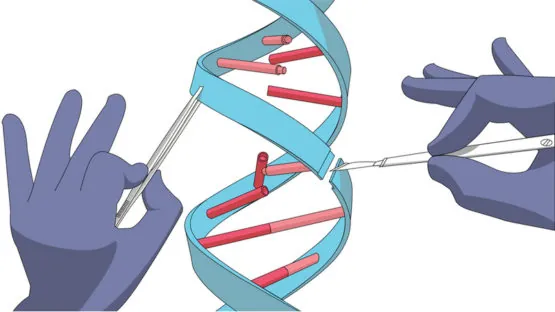New research has shown that a DNA repair gene modulates lifespan in mice [1]. This may serve as a therapeutic avenue or at least open the way towards dissecting the links between DNA damage and senescence.
MYSM1 is a gene that removes a molecular mark known as ubiquitin from histones, which are scaffolding proteins that are central to packaging DNA and organizing its three-dimensional structure. The gene is known to be active in a variety of cell types and has been linked with various processes, including skin development, antiviral signaling, and bone marrow maintenance.
One specific DNA repair pathway affectedA recent study found that MYSM1 is more strongly expressed after DNA damage and that a lack of MYSM1 decreased the lifespan of mice [2]. Now, researchers at Wuhan University in China have built on those findings to show that MYSM1 plays a key role in aging by regulating the repair of DNA damage.
By treating cultured mouse cells with DOX, a drug that induces DNA damage, the team tested the role of MYSM1. A protein associated with DNA damage stayed highly induced for longer in cells with a mutated form of MYSM1, and dosing the cells with functional MYSM1 brought the levels down. The researchers also monitored different DNA repair pathways – homologous recombination (HR) and non-homologous end joining (NHEJ) – and found that HR efficiency was affected by the presence or absence of MYSM1, while NHEJ efficiency wasn’t. Based on these findings, they concluded that MYSM1 regulates HR-mediated repair of DNA damage.
Senescence, lifespan, and age-related diseasesSince DNA damage causes cells to undergo apoptosis or senescence, the team next checked whether MYSM1 is linked with cellular senescence. They found that MYSM1 protein and mRNA levels were lower in the tissues of 22-month old mice than 2-month old mice. In addition, cells with mutated MYSM1 had significantly more of a molecular marker of senescence.
With evidence linking MYSM1 to DNA repair and senescence prevention on the cellular level, the team turned to the question of what effect it has on the whole organism. They confirmed that MYSM1 deficiency shortens the lifespan of mice, causing a reduction in size, eye disease, cataracts, and a range of organ defects. Mice lacking MYSM1 died when they were between 5 and 13 months old, while the wild-type mice were all still alive after 15 months.
The opposite happened when MYSM1 levels were boosted. When mice that were 14 or 16 months old were injected with a MYSM1 vector for two months or six months, they remained healthier than mice that received a control treatment. The MYSM1-treated mice didn’t lose their hair, their organs were in better shape, and they didn’t develop the aged behaviors seen in the control mice. The control mice all died when they were between 22 and 26 months old, but only one of the treated mice died at 28 months of age – the rest lived until they were 30 months old, when the experiment stopped.
Aging is a universal feature of life that is a major focus of scientific research and a risk factor in many diseases. A comprehensive understanding of the cellular and molecular mechanisms of aging are critical to the prevention of the secretion of excessive proinflammatory diseases associated with the aging process. Here, it is shown that MYSM1 is a key suppressor of aging and aging-related pathologies. MYSM1 functionally represses cellular senescence and the aging process in human and mice primary cells and in mice organs. MYSM1 mechanistically attenuates the aging process by promoting DNA repair processes. Remarkably, MYSM1 deficiency facilitates the aging process and reduces lifespan, whereas MYSM1 over-expression attenuates the aging process and increases lifespan in mice. The functional role of MYSM1 is demonstrated in suppressing the aging process and prolonging lifespan. MYSM1 is a key suppressor of aging and may act as a potential agent for the prevention of aging and aging-associated diseases.
Conclusion
These findings clearly demonstrate a key role for MYSM1 in aging. By activating a DNA repair pathway, it prevents the accumulation of DNA damage and thus delays cellular senescence. How effective MYSM1 will be as a therapeutic target will depend, among other things, on what other processes it regulates, but even if it proves to be a poor target for therapies, it is nevertheless valuable as one more piece of the puzzle that is biological aging.
Literature
- Tian M, Huang Y, Song Y, Li W, Zhao P, Liu W, Wu K, and Wu J. MYSM1 Suppresses Cellular Senescence and the Aging Process to Prolong Lifespan. Advanced Science (2020), doi: 10.1002/advs.202001950
- Kroeger C, Roesler R, Wiese S, Hainzl A, and Gatzka MV. Interaction of Deubiquitinase 2A-DUB/MYSM1 with DNA Repair and Replication Factors. International Journal of Molecular Sciences (2020), doi: 10.3390/ijms21113762



